-
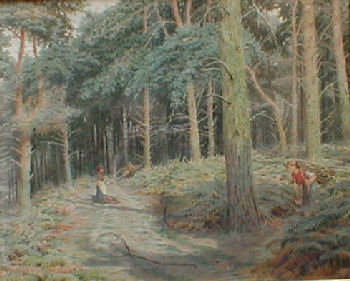 Watercolour, 11x17cm. James Barnes 1870 - 1920 James Barnes exhibited a staggering 131 works at the Walker Art Gallery in Liverpool, during his lifetime. A painter of great skill, his work has a wonderful ethereal feeling, as well as the genuine touch of the Liverpool school at this period. He appears to have spent his entire working life in Liverpool, and his commitment to the Walker Art Gallery is obvious. He exhibited at the principal galleries, both in the provinces and London, including the Royal academy. The theme of this painting appears to have been a particular favourite of the artist.
Watercolour, 11x17cm. James Barnes 1870 - 1920 James Barnes exhibited a staggering 131 works at the Walker Art Gallery in Liverpool, during his lifetime. A painter of great skill, his work has a wonderful ethereal feeling, as well as the genuine touch of the Liverpool school at this period. He appears to have spent his entire working life in Liverpool, and his commitment to the Walker Art Gallery is obvious. He exhibited at the principal galleries, both in the provinces and London, including the Royal academy. The theme of this painting appears to have been a particular favourite of the artist. -
Sold
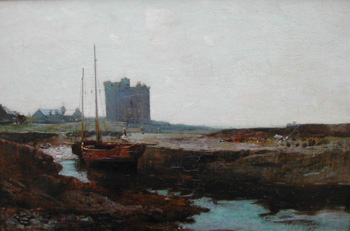 Oil on Canvas, 57x43cm. James Campbell Noble R.S.A. 1846 - 1913 James Campbell Noble was born in Edinburgh, studying first at the board of manufacture in Edinburge and later at the school of the Royal Scottish Academy under J.P.Charles and McTaggart where he won the Keith prize. He exhibited in London at the Royal Academy in 1880 and was elected as a full member of the Royal Scottish Academy in 1892.
Oil on Canvas, 57x43cm. James Campbell Noble R.S.A. 1846 - 1913 James Campbell Noble was born in Edinburgh, studying first at the board of manufacture in Edinburge and later at the school of the Royal Scottish Academy under J.P.Charles and McTaggart where he won the Keith prize. He exhibited in London at the Royal Academy in 1880 and was elected as a full member of the Royal Scottish Academy in 1892. -
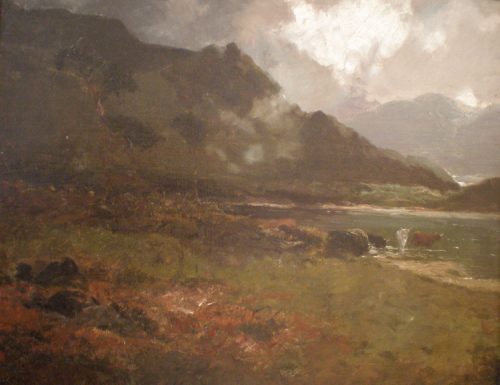 Oil on Board, 40x32cm. James Docharty A.R.S.A. 1829-1878 Docharty was born in the calico-printing district of the Vale of Leven, at Bonhill, near Bumbarton, where his father was employed in one of the numerous works for which that locality divides its fame with football playing. He served his apprenticeship as a pattern designer, which profession he persued in Glasgow until about 1861, when he took seriously to the profession of a landscape-painter, for which he always had a strong predilection. His first studies of any consequence were made at the village of Ardenadarn, a watering place on the Holy Loch on the Clyde, after which the establishment of the Glasgow Institute of the Fine Arts afforded him an opportunity of putting his works before the public. The quality of his landscapes, in which the character of Scottish landscape was simply and truthfully delineated, rapidly brought him into notice, and led to his election as an Associate of the Scottish Academy in 1877. He was a regular exhibitor at the local exhibitions, the Scottish Academy, and during the last few years of his life, at the Royal Academy, where his works were favourably noticed. In the spring on 1866, on account of his heath begining to fail, he left for a trip to Egypt, in the course of which he made some sketches of Nile scenery which he never wrought out; and afterwards spent some months at the Isle of Wight, in spite of the pulmonary complaint from which he had been suffering terminated fatally in Glasgow in 1878.
Oil on Board, 40x32cm. James Docharty A.R.S.A. 1829-1878 Docharty was born in the calico-printing district of the Vale of Leven, at Bonhill, near Bumbarton, where his father was employed in one of the numerous works for which that locality divides its fame with football playing. He served his apprenticeship as a pattern designer, which profession he persued in Glasgow until about 1861, when he took seriously to the profession of a landscape-painter, for which he always had a strong predilection. His first studies of any consequence were made at the village of Ardenadarn, a watering place on the Holy Loch on the Clyde, after which the establishment of the Glasgow Institute of the Fine Arts afforded him an opportunity of putting his works before the public. The quality of his landscapes, in which the character of Scottish landscape was simply and truthfully delineated, rapidly brought him into notice, and led to his election as an Associate of the Scottish Academy in 1877. He was a regular exhibitor at the local exhibitions, the Scottish Academy, and during the last few years of his life, at the Royal Academy, where his works were favourably noticed. In the spring on 1866, on account of his heath begining to fail, he left for a trip to Egypt, in the course of which he made some sketches of Nile scenery which he never wrought out; and afterwards spent some months at the Isle of Wight, in spite of the pulmonary complaint from which he had been suffering terminated fatally in Glasgow in 1878. -
Sold
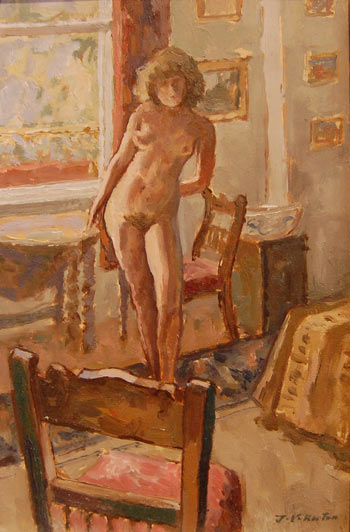 Oil on Board, 38x47cm. James Horton R.B.A. b.1948 James Horton studied first at the Sir John Cass School of Art and then at the Royal College of Art. He was quickly given his first one-man show at the Hay Galleries, Hay on Wye and quickly followed with others in Belfast, Dublin, Cambridge and Stockholm. Horton has exhibited at many principal London galleries including the Royal Academy, Royal Society of British Artists, Royal Portrait Society, New English Art Club etc. Additional information on request.
Oil on Board, 38x47cm. James Horton R.B.A. b.1948 James Horton studied first at the Sir John Cass School of Art and then at the Royal College of Art. He was quickly given his first one-man show at the Hay Galleries, Hay on Wye and quickly followed with others in Belfast, Dublin, Cambridge and Stockholm. Horton has exhibited at many principal London galleries including the Royal Academy, Royal Society of British Artists, Royal Portrait Society, New English Art Club etc. Additional information on request. -
Sold
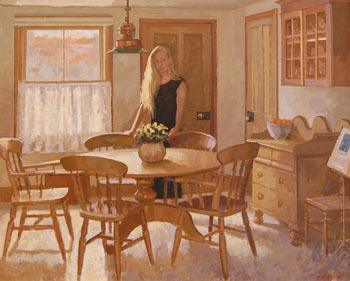 Oil on Canvas, 100x87cm. James Horton R.B.A. b.1948 James Horton studied first at the Sir John Cass School of Art and then at the Royal College of Art. He was quickly given his first one-man show at the Hay Galleries, Hay on Wye and quickly followed with others in Belfast, Dublin, Cambridge and Stockholm. Horton has exhibited at many principal London galleries including the Royal Academy, Royal Society of British Artists, Royal Portrait Society, New English Art Club etc. Additional information on request.
Oil on Canvas, 100x87cm. James Horton R.B.A. b.1948 James Horton studied first at the Sir John Cass School of Art and then at the Royal College of Art. He was quickly given his first one-man show at the Hay Galleries, Hay on Wye and quickly followed with others in Belfast, Dublin, Cambridge and Stockholm. Horton has exhibited at many principal London galleries including the Royal Academy, Royal Society of British Artists, Royal Portrait Society, New English Art Club etc. Additional information on request. -
Sold
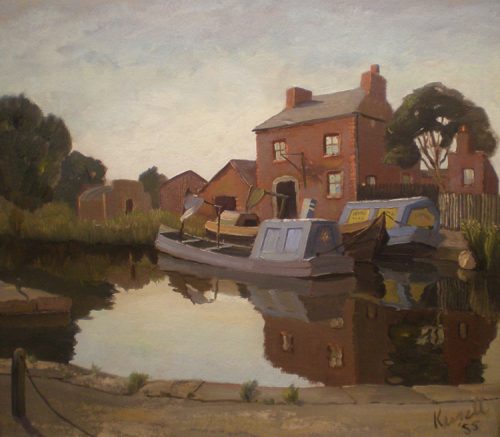 Oil on Board, 90x80cm. James Kessell 1915-1978 Provenance : Ex-private collection, R.O.I. exhibit 1953. Born in Coventry, James Kessell specialised in oils. He was the son of James Everett Kessell and studied at the Coventry School of Art from 1928-1934. He exhibited at numerous principal galleries including the Royal Academy, Royal Institute of Oil Painters, Royal Society of British Artists, Royal Society of Marine Artists etc. His work is held in a number of public collections.
Oil on Board, 90x80cm. James Kessell 1915-1978 Provenance : Ex-private collection, R.O.I. exhibit 1953. Born in Coventry, James Kessell specialised in oils. He was the son of James Everett Kessell and studied at the Coventry School of Art from 1928-1934. He exhibited at numerous principal galleries including the Royal Academy, Royal Institute of Oil Painters, Royal Society of British Artists, Royal Society of Marine Artists etc. His work is held in a number of public collections. -
Sold
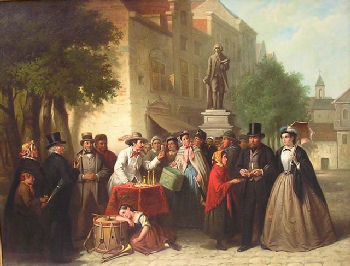 Oil on Canvas, 40x32cm. Jacobus Matthys Damschroeder 1825 - 1905 Born in Germany, Jan Damschroeder spent most of his life working in Amsterdam, where we believe this work to be set. He specialised in genre paintings, often with the inclusion of children. A painting entitled 'The Village School' was sold at a London auction house c.1900 for what was then the considerable sum of 30 guineas. Damschroeder worked in both oils and watercolours, often painting on a more modest scale than this example. It would seem that this is a major large work and was painted as an exhibition piece.
Oil on Canvas, 40x32cm. Jacobus Matthys Damschroeder 1825 - 1905 Born in Germany, Jan Damschroeder spent most of his life working in Amsterdam, where we believe this work to be set. He specialised in genre paintings, often with the inclusion of children. A painting entitled 'The Village School' was sold at a London auction house c.1900 for what was then the considerable sum of 30 guineas. Damschroeder worked in both oils and watercolours, often painting on a more modest scale than this example. It would seem that this is a major large work and was painted as an exhibition piece. -
Sold
 Oil, 40x30cm. Anthony Park R.O.I., R.B.A. 1880 - 1962 Park moved to St. Ives at the age of 18 and became probably the best known of the early St. Ives painters. He studied under Julian Olsson who encouraged him to study in Paris. From 1905 he attended the Atelier Colarossi where he was a contemporary of Modigliani. Strongly influenced by the French Impressionists, Park's work is always brightly coloured and spontaneous. He had worked in the cotton mills of his native Lancashire throughout much of his childhood. Although he had no official training during his first years painting in St. Ives, Park was fortunate enough to meet Julius Olsson, one of the earliest arrivals among the many painters who had settled in St. Ives towards the end of the nineteenth century. Olsson was the founder of the new School of Landscape and Marine Painting which he had set up in his own studio overlooking Porthmeor Beach. He offered Park free tuition on account of his willingness to learn and natural ability and within six years of arriving in St. Ives, Park had begun exhibiting at the Royal Academy and it was at this time, with Olsson's guidance, that he decided to continue his training in the ateliers of Paris. Returning to St. Ives in 1923, Park found the old fishing port provided him with countless subjects among the many boats coming and going in the busy harbour and the overlapping forms of the fisherman's cottages rising steeply on the hill overlooking the port. Park exhibited at the Royal Academy from 1905 to 1949 and he was elected as a member of the Royal Society of Oil Painters in 1923. He was a founder member of the St. Ives Society of Artists in 1927. With regular entries to the Paris Salon he was awarded the Gold Medal in 1934. Park was among a small group of professional artists who carried on the tradition of St. Ives painting in the quiet years between the wars. He exhibited costal and fishing scenes at the Royal Academy, the Paris Salon and St. Ives Society of Artists. His work is held in the public collections of Manchester City Art, Salford Art Gallery and the Tate.
Oil, 40x30cm. Anthony Park R.O.I., R.B.A. 1880 - 1962 Park moved to St. Ives at the age of 18 and became probably the best known of the early St. Ives painters. He studied under Julian Olsson who encouraged him to study in Paris. From 1905 he attended the Atelier Colarossi where he was a contemporary of Modigliani. Strongly influenced by the French Impressionists, Park's work is always brightly coloured and spontaneous. He had worked in the cotton mills of his native Lancashire throughout much of his childhood. Although he had no official training during his first years painting in St. Ives, Park was fortunate enough to meet Julius Olsson, one of the earliest arrivals among the many painters who had settled in St. Ives towards the end of the nineteenth century. Olsson was the founder of the new School of Landscape and Marine Painting which he had set up in his own studio overlooking Porthmeor Beach. He offered Park free tuition on account of his willingness to learn and natural ability and within six years of arriving in St. Ives, Park had begun exhibiting at the Royal Academy and it was at this time, with Olsson's guidance, that he decided to continue his training in the ateliers of Paris. Returning to St. Ives in 1923, Park found the old fishing port provided him with countless subjects among the many boats coming and going in the busy harbour and the overlapping forms of the fisherman's cottages rising steeply on the hill overlooking the port. Park exhibited at the Royal Academy from 1905 to 1949 and he was elected as a member of the Royal Society of Oil Painters in 1923. He was a founder member of the St. Ives Society of Artists in 1927. With regular entries to the Paris Salon he was awarded the Gold Medal in 1934. Park was among a small group of professional artists who carried on the tradition of St. Ives painting in the quiet years between the wars. He exhibited costal and fishing scenes at the Royal Academy, the Paris Salon and St. Ives Society of Artists. His work is held in the public collections of Manchester City Art, Salford Art Gallery and the Tate. -
Sold
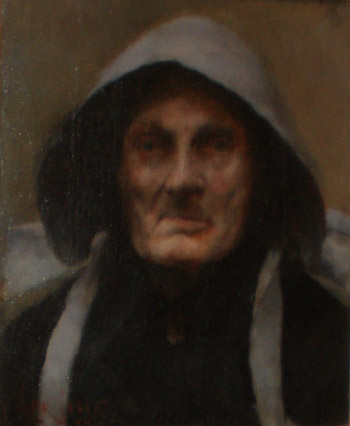 Oil on Canvas, 37x40cm. Costa 1867-1931 An important portrait from the Newlyn School by the highly desirable portrait painter John da Costa. The painting is signed and importantly dated 1890 when Newlyn painting and painters were at the height of their influence in British art. In 1890 a writer mentioned Stanhope Forbes' old studio and then went on 'Now it is occupied by the youngest member of the Newlyn colony, Mr. John da Costa, fresh from the Paris schooles, and barely twenty three, has yet had a picture on the line at the Grovesnor and another at the Academy'. John da Costa was born in Teignmouth and was recognised as an artist of great potential early in his career by Frederick, Lord Leighton. He received awards at the Paris Salon in 1906 and 1907, and he was a member of the Royal Institute of Oil Painters and the Royal Society of Portrait Painters. In 1974 a memorial exhibition was dedicated to John da Costa of paintings from the collection of Mrs. Elizabeth M. Richards at Leighton House, London.
Oil on Canvas, 37x40cm. Costa 1867-1931 An important portrait from the Newlyn School by the highly desirable portrait painter John da Costa. The painting is signed and importantly dated 1890 when Newlyn painting and painters were at the height of their influence in British art. In 1890 a writer mentioned Stanhope Forbes' old studio and then went on 'Now it is occupied by the youngest member of the Newlyn colony, Mr. John da Costa, fresh from the Paris schooles, and barely twenty three, has yet had a picture on the line at the Grovesnor and another at the Academy'. John da Costa was born in Teignmouth and was recognised as an artist of great potential early in his career by Frederick, Lord Leighton. He received awards at the Paris Salon in 1906 and 1907, and he was a member of the Royal Institute of Oil Painters and the Royal Society of Portrait Painters. In 1974 a memorial exhibition was dedicated to John da Costa of paintings from the collection of Mrs. Elizabeth M. Richards at Leighton House, London. -
Sold
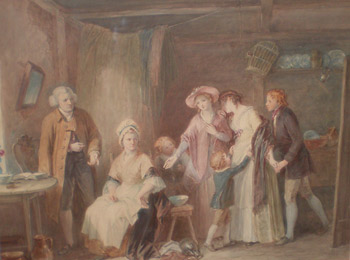 Watercolour, 72x63cm. Massey Wright 1777-1866 Provenance: Another version by the artist is in the collection of the Victoria and Albert Museum. Born in London, John Massey Wright began to exhibit at the Royal Academy in 1808. He married Ann Meadows in 1809 and they continued to live in central London. In 1820 he joined the Old Watercolour Society, and he continued to be a member until his death in 1866. Massey Wright produced several bodies of work as a figure painter, watercolourist and later as an illustrator, illustrating work by writers such as Walter Scott, Robert Burns, Mary Shelley and Byron.
Watercolour, 72x63cm. Massey Wright 1777-1866 Provenance: Another version by the artist is in the collection of the Victoria and Albert Museum. Born in London, John Massey Wright began to exhibit at the Royal Academy in 1808. He married Ann Meadows in 1809 and they continued to live in central London. In 1820 he joined the Old Watercolour Society, and he continued to be a member until his death in 1866. Massey Wright produced several bodies of work as a figure painter, watercolourist and later as an illustrator, illustrating work by writers such as Walter Scott, Robert Burns, Mary Shelley and Byron. -
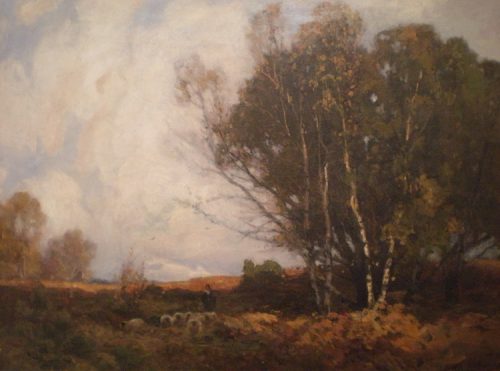 Oil on Canvas, 98x77cm. Noble Barlow R.B.A. 1861 - 1917 John Noble Barlow was born in Manchester in 1861. He studied art at the Academie Julian in Paris under Jules Joseph Lefebre, Paul Delance and Constant. After leaving Paris he continued his studies in Belgium, Holland and New York. He became a U.S. citizen in 1887 where he lived in Providence, Rhode Island, becoming a member of the Providence Art Club. During this period he exhibited at the National Academy of Design and the Art Institute of Chicago. Some five years later he returned to England and St. Ives. He soon gained a reputation and was elected a member of the Society of British Artists and was a successful medal winner at the Paris Salon in 1899 and in 1900 at the Paris Exposition. For many years he maintained a studio at Lamorna Valley. John Barlow was en exceptional landscape painter as this example clearly indicates. His work is held in a number of public collections both in the U.S.A. and at home. The Rhode Island School of Design museum currently displays three of his works. Many of the artist's pupils at the John Barlow School of Art became successful painters including Garstin Cox, William Cox, Herbert George, Anna Hills and Edgar Nye.
Oil on Canvas, 98x77cm. Noble Barlow R.B.A. 1861 - 1917 John Noble Barlow was born in Manchester in 1861. He studied art at the Academie Julian in Paris under Jules Joseph Lefebre, Paul Delance and Constant. After leaving Paris he continued his studies in Belgium, Holland and New York. He became a U.S. citizen in 1887 where he lived in Providence, Rhode Island, becoming a member of the Providence Art Club. During this period he exhibited at the National Academy of Design and the Art Institute of Chicago. Some five years later he returned to England and St. Ives. He soon gained a reputation and was elected a member of the Society of British Artists and was a successful medal winner at the Paris Salon in 1899 and in 1900 at the Paris Exposition. For many years he maintained a studio at Lamorna Valley. John Barlow was en exceptional landscape painter as this example clearly indicates. His work is held in a number of public collections both in the U.S.A. and at home. The Rhode Island School of Design museum currently displays three of his works. Many of the artist's pupils at the John Barlow School of Art became successful painters including Garstin Cox, William Cox, Herbert George, Anna Hills and Edgar Nye. -
Sold
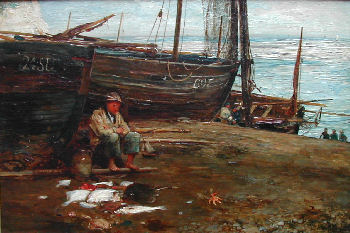 Oil on Canvas, 11x17cm. Robertson Reid 1857 - 1926 Born in Edinburgh, he studied at the Royal Scottish Academy Schools before moving to Cornwall and later to London. He became interested in the Social Realism movement and was probably influenced by Bastien Lepage. In 1879 his painting 'Toil and Pleasure' was hung at the Royal Academy, illustrating his debt to Lepage. That painting was purchased for the nation by the Chantrey Bequest. George Clausen was a friend of the artist and they lived close to each other in Hampstead. Clausen was stimulated by Reid's work and had a considerable influence at this time. Reid chose subjects of field workers and humble people and his style has a particular dynamism, influenced no doubt by the early teachings of Chalmers and McTaggart. A good colourist, he painted a number of works of fishermen and women with rich vibrant colours as this example illustrated. The artist knew the Glasgow Boys and influenced their early work. He was an important and influential Scottish artist.
Oil on Canvas, 11x17cm. Robertson Reid 1857 - 1926 Born in Edinburgh, he studied at the Royal Scottish Academy Schools before moving to Cornwall and later to London. He became interested in the Social Realism movement and was probably influenced by Bastien Lepage. In 1879 his painting 'Toil and Pleasure' was hung at the Royal Academy, illustrating his debt to Lepage. That painting was purchased for the nation by the Chantrey Bequest. George Clausen was a friend of the artist and they lived close to each other in Hampstead. Clausen was stimulated by Reid's work and had a considerable influence at this time. Reid chose subjects of field workers and humble people and his style has a particular dynamism, influenced no doubt by the early teachings of Chalmers and McTaggart. A good colourist, he painted a number of works of fishermen and women with rich vibrant colours as this example illustrated. The artist knew the Glasgow Boys and influenced their early work. He was an important and influential Scottish artist. -
Sold
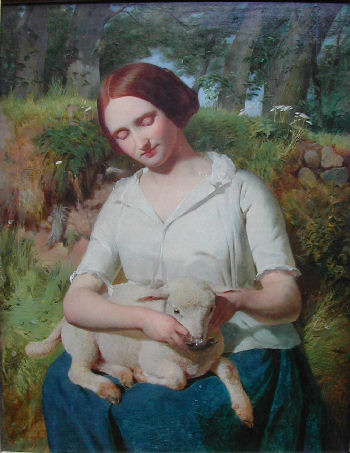 Oil on Canvas, 13x17cm. Stirling 1820 - 1871 Provenance: Exhibited at the Royal Academy 1853. John Stirling first exhibited three portraits at the Royal Academy in 1852. In the same year Holman Hunt's masterpiece 'The Hireling Shepherd' was hung in the Academy and it is more than likely that John Stirling would have seen the work of the Pre-Raphaelites for the first time on a visit to London from Aberdeen to see his own work hung. The work of the Pre-Raphaelites was first seen in 1849 and the brotherhood existed for a period of about five years from that date. It seems certain that John Stirling was impressed by the work of the Pre-Raphaelites and was influenced by them when he produced his painting 'The Lassie and the Lamb', which was exhibited at the Academy in 1853. The technique used by such artists as Holman Hunt and Millais was to paint in pure colour on a white, wet ground which produced a distinctive luminosity as was a technique Stirling also employed in 'The Lassie and the Lamb'. Similarly, the Pre-Raphaelite's great attention to detail and most particularly in the cases of Hunt and Millais, their wish to reflect nature accurately is reflected in John Stirling's painting. While the Pre-Raphaelite Brotherhood was not without its detractors, Charles Dickens for one, its great champion was the foremost Victorian critic and painter John Ruskin. He took notice of the work of John Stirling and in 'Academy Notes' of 1855 commented on Stirling's Academy painting: 'The Scottish Presbyterians' describing it as '...a very acceptable picture, showing careful study and good discrimination.' The title of the painting 'The Lassie and the Lamb' is taken from Wordsworth's poem 'The Pet Lamb', a pastoral. In later works, the artist took poetry for a direct inspiration for his subjects which were the Pre-Raphaelite Brotherhood's oeuvre. The Pre-Raphaelites had a considerable influence on a number of painters and there can be little doubt that John Stirling's painting 'The Lassie and the Lamb' falls safely into the Pre-Raphaelite category. John Stirling exhibited his first works at the Royal Academy in 1852 and continued to exhibit there until 1871, the year he died. His first paintings were exhibited from an Aberdeen address, although it seems he also lived in London, since the pictures were sent both from Aberdeen and London during his active years. A number of his later works are a result of his visits to Morocco in 1868 and 1869. His three exhibits at the Royal Academy in 1869 were 'Al Sok', a market in Morocco, 'Repas Honnetre' and Al-Ghirab, a water seller in Morocco.
Oil on Canvas, 13x17cm. Stirling 1820 - 1871 Provenance: Exhibited at the Royal Academy 1853. John Stirling first exhibited three portraits at the Royal Academy in 1852. In the same year Holman Hunt's masterpiece 'The Hireling Shepherd' was hung in the Academy and it is more than likely that John Stirling would have seen the work of the Pre-Raphaelites for the first time on a visit to London from Aberdeen to see his own work hung. The work of the Pre-Raphaelites was first seen in 1849 and the brotherhood existed for a period of about five years from that date. It seems certain that John Stirling was impressed by the work of the Pre-Raphaelites and was influenced by them when he produced his painting 'The Lassie and the Lamb', which was exhibited at the Academy in 1853. The technique used by such artists as Holman Hunt and Millais was to paint in pure colour on a white, wet ground which produced a distinctive luminosity as was a technique Stirling also employed in 'The Lassie and the Lamb'. Similarly, the Pre-Raphaelite's great attention to detail and most particularly in the cases of Hunt and Millais, their wish to reflect nature accurately is reflected in John Stirling's painting. While the Pre-Raphaelite Brotherhood was not without its detractors, Charles Dickens for one, its great champion was the foremost Victorian critic and painter John Ruskin. He took notice of the work of John Stirling and in 'Academy Notes' of 1855 commented on Stirling's Academy painting: 'The Scottish Presbyterians' describing it as '...a very acceptable picture, showing careful study and good discrimination.' The title of the painting 'The Lassie and the Lamb' is taken from Wordsworth's poem 'The Pet Lamb', a pastoral. In later works, the artist took poetry for a direct inspiration for his subjects which were the Pre-Raphaelite Brotherhood's oeuvre. The Pre-Raphaelites had a considerable influence on a number of painters and there can be little doubt that John Stirling's painting 'The Lassie and the Lamb' falls safely into the Pre-Raphaelite category. John Stirling exhibited his first works at the Royal Academy in 1852 and continued to exhibit there until 1871, the year he died. His first paintings were exhibited from an Aberdeen address, although it seems he also lived in London, since the pictures were sent both from Aberdeen and London during his active years. A number of his later works are a result of his visits to Morocco in 1868 and 1869. His three exhibits at the Royal Academy in 1869 were 'Al Sok', a market in Morocco, 'Repas Honnetre' and Al-Ghirab, a water seller in Morocco. -
Sold
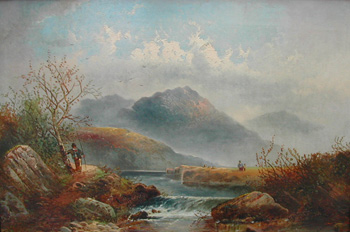 Oil on Canvas, 56x40cm. Joseph Horlor 1809 - 1887 One of the best known West Country painters of his period and like many others working at this time he visited Wales on frequent occasions. He adopted a free and loose style and his sense of light for dramatic effect is highly succesful. He exhibited at the Royal Academy, Suffolk Street and other principal galleries.
Oil on Canvas, 56x40cm. Joseph Horlor 1809 - 1887 One of the best known West Country painters of his period and like many others working at this time he visited Wales on frequent occasions. He adopted a free and loose style and his sense of light for dramatic effect is highly succesful. He exhibited at the Royal Academy, Suffolk Street and other principal galleries. -
Sold
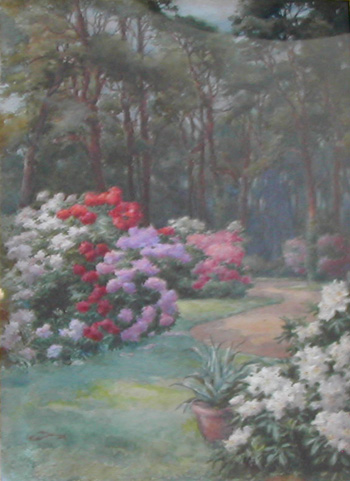 Watercolour, 44x54cm. Joseph Twigg 1884 - 1912 Provenance : Dudley Gallery (original label verso). A superb example of the work of watercolourist Joseph Twigg. In original condition it is mounted in an excellent water gilded watts frame. The artist specialised in landscape and architectural subjects and exhibited in London at principal galleries that included the Royal Academy and the Royal Institute. His principal gallery, the Dudley Gallery, was a regular venue for his work. He lived at various times in Walton on Thames, Eastbourne and Northwood in Middlesex.
Watercolour, 44x54cm. Joseph Twigg 1884 - 1912 Provenance : Dudley Gallery (original label verso). A superb example of the work of watercolourist Joseph Twigg. In original condition it is mounted in an excellent water gilded watts frame. The artist specialised in landscape and architectural subjects and exhibited in London at principal galleries that included the Royal Academy and the Royal Institute. His principal gallery, the Dudley Gallery, was a regular venue for his work. He lived at various times in Walton on Thames, Eastbourne and Northwood in Middlesex. -
Sold
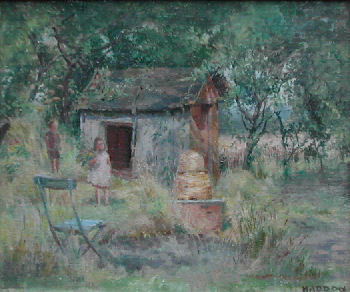 Oil on Board, 60x80cm. Joyce Critchley Haddon R.B.A., N.E.A.C. b.1915 Joyce Haddon studied at Cambridge and the Royal Academy schools where she won the Creswick medal for landscape and the Landseer prize for landscape, drawing and painting from the antique. Her work was exhibited at the Royal Academy with exhibitions in Paris, Sydney, Belfast, Birmingham and many more. She was elected a member of the Royal Society of British Artists and the New English Art Club, showing her work regularly at their annual exhibitions. Her daughter, the journalist Celia Haddon said of her mother, 'she saw the inward light in the commonplace'.
Oil on Board, 60x80cm. Joyce Critchley Haddon R.B.A., N.E.A.C. b.1915 Joyce Haddon studied at Cambridge and the Royal Academy schools where she won the Creswick medal for landscape and the Landseer prize for landscape, drawing and painting from the antique. Her work was exhibited at the Royal Academy with exhibitions in Paris, Sydney, Belfast, Birmingham and many more. She was elected a member of the Royal Society of British Artists and the New English Art Club, showing her work regularly at their annual exhibitions. Her daughter, the journalist Celia Haddon said of her mother, 'she saw the inward light in the commonplace'. -
Sold
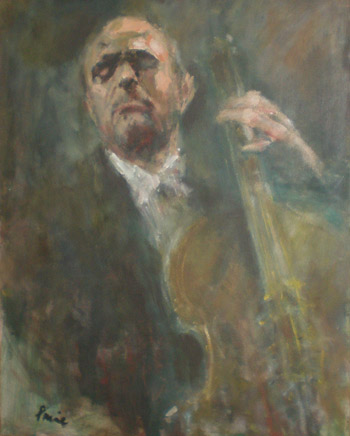 Oil on Canvas, 78x94cm. b.1926 Ken Paine was born in Lambeth, London in 1926. He studied at Twickenham College of Art and later with R.O. Dunlop RA. After travelling extensively for several years, the artist settled in the United States. It was during this time that he further developed his interest in portraiture, and of the character studies which have become his life's work. He travelled all around the States, painting people from all walks of life, before returning to England to set up his studio. Since 1962 the Royal Society of Portrait Painters and the Pastel Society have exhibited his work, and his commissions have included many dignitaries and celebrities. Paine is a member of the Pastel Society and the Societie des Pastellistes de France. He has won numerous awards for his portraiture both in the UK and France. His work has been exhibited widely over the years and he has held many solo exhibitions. In 1999 a major retrospective of his work was stages in Bath Museum. In 2004 Toulouse Museum acquired two of his works. Ken Paine works in all media, but pastel is the medium for which he is most well known. His work leans towards the romantic and shows genuine pathos without being sentimental. The vitality revealed in his portraits can be awe-inspiring. The artist's empathy with his subjects produces a quite unique artistic result which is admired world wide. A beautifully illustrated biography: 'Ken Paine - His life and work' by Michael Simonow, was published by Mechanick Excersises in 1997. In 2001 an hour long documentary on his life and work was commissioned by Sky Television's cultural channel. Purchased from a private collection, full provenance and additional information is available.
Oil on Canvas, 78x94cm. b.1926 Ken Paine was born in Lambeth, London in 1926. He studied at Twickenham College of Art and later with R.O. Dunlop RA. After travelling extensively for several years, the artist settled in the United States. It was during this time that he further developed his interest in portraiture, and of the character studies which have become his life's work. He travelled all around the States, painting people from all walks of life, before returning to England to set up his studio. Since 1962 the Royal Society of Portrait Painters and the Pastel Society have exhibited his work, and his commissions have included many dignitaries and celebrities. Paine is a member of the Pastel Society and the Societie des Pastellistes de France. He has won numerous awards for his portraiture both in the UK and France. His work has been exhibited widely over the years and he has held many solo exhibitions. In 1999 a major retrospective of his work was stages in Bath Museum. In 2004 Toulouse Museum acquired two of his works. Ken Paine works in all media, but pastel is the medium for which he is most well known. His work leans towards the romantic and shows genuine pathos without being sentimental. The vitality revealed in his portraits can be awe-inspiring. The artist's empathy with his subjects produces a quite unique artistic result which is admired world wide. A beautifully illustrated biography: 'Ken Paine - His life and work' by Michael Simonow, was published by Mechanick Excersises in 1997. In 2001 an hour long documentary on his life and work was commissioned by Sky Television's cultural channel. Purchased from a private collection, full provenance and additional information is available. -
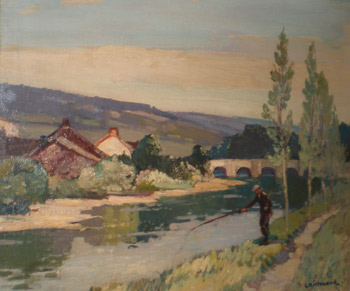 Oil on Canvas, 75x63cm. Leonard Richmond R.B.A., R.I., R.O.I., P.S. d.1965 Leonard Richmond studied at the Taunton School of Art and Chelsea Polytechnic. He was a prolific exhibitor at the Fine Art Society, Royal Academy, Cooling and Walker's Galleries and also showed widely overseas winning a number of awards. These included the Tuthill prize at the Chicago International Watercolour Exhibition in 1928 and in 1947 a silver medal at the Paris Salon.
Oil on Canvas, 75x63cm. Leonard Richmond R.B.A., R.I., R.O.I., P.S. d.1965 Leonard Richmond studied at the Taunton School of Art and Chelsea Polytechnic. He was a prolific exhibitor at the Fine Art Society, Royal Academy, Cooling and Walker's Galleries and also showed widely overseas winning a number of awards. These included the Tuthill prize at the Chicago International Watercolour Exhibition in 1928 and in 1947 a silver medal at the Paris Salon. -
Sold
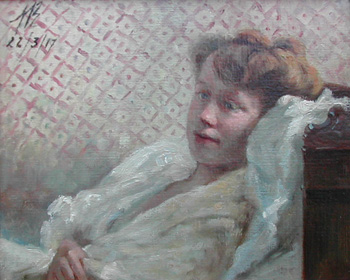 Oil on Board, 35x30cm. Marius Alexander Jacques Bauer 1867 - 1932 Considered one of the most important Belgian painters of his period this painting executed during the First World War is particularly poignant. The recent revival of interest in Orientalism has led to the rediscovery of the Dutch artist Marius Bauer. Bauer was an inveterate traveller, going off to India, Indonesia, Turkey, Palestine and Morocco among other destinations. In 1888 he was given the opportunity to make his first trip east, to Istanbul, by the art dealer E.J. van Wisselingh. He returned with more than 100 drawings and several full sketchbooks. This pattern repeated itself again and again. Among the cities he visited were Cairo, Luxor, Jerusalem, Agra and Benares. He was irresistably drawn to street life, the colourful populace and the exotic landscape of parts of the world that were then unfamiliar to most people. There Bauer found inspiration for spacious landscapes and picturesque city scenes. In addition to drawings, he also made etchings, aquarelles anf paintings. (Singer Museum)
Oil on Board, 35x30cm. Marius Alexander Jacques Bauer 1867 - 1932 Considered one of the most important Belgian painters of his period this painting executed during the First World War is particularly poignant. The recent revival of interest in Orientalism has led to the rediscovery of the Dutch artist Marius Bauer. Bauer was an inveterate traveller, going off to India, Indonesia, Turkey, Palestine and Morocco among other destinations. In 1888 he was given the opportunity to make his first trip east, to Istanbul, by the art dealer E.J. van Wisselingh. He returned with more than 100 drawings and several full sketchbooks. This pattern repeated itself again and again. Among the cities he visited were Cairo, Luxor, Jerusalem, Agra and Benares. He was irresistably drawn to street life, the colourful populace and the exotic landscape of parts of the world that were then unfamiliar to most people. There Bauer found inspiration for spacious landscapes and picturesque city scenes. In addition to drawings, he also made etchings, aquarelles anf paintings. (Singer Museum) -
Sold
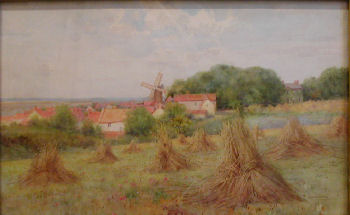 Hagarty exh. 1882 - 1928 A highly successful artist, Mary Hagarty was elected a full member of the Society of Women Artists in 1918. Principally a watercolour painter, she painted the landscape of England and Wales and held a strong affection for Venice where she exhibited many works of the city. She lived for some time in both London and Liverpool and exhibited 131 works at the Walker Art Gallery and numerous works at the principal London galleries, including the Royal Academy, Royal Institute and the Royal Society of British Artists.
Hagarty exh. 1882 - 1928 A highly successful artist, Mary Hagarty was elected a full member of the Society of Women Artists in 1918. Principally a watercolour painter, she painted the landscape of England and Wales and held a strong affection for Venice where she exhibited many works of the city. She lived for some time in both London and Liverpool and exhibited 131 works at the Walker Art Gallery and numerous works at the principal London galleries, including the Royal Academy, Royal Institute and the Royal Society of British Artists. -
Sold
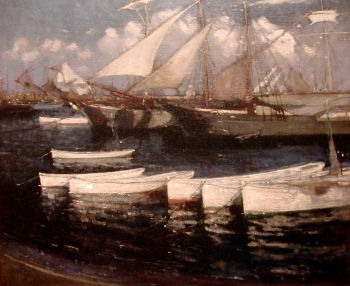 Oil on Canvas, 22x16cm. Maccrossan 1863 - 1934 Ex private collection. Provenance: Royal Academy Exhibit 1898 'White Gigs' no. 513 (This was Mary Maccrossans first Royal Academy Exhibit, purchased by the Liverpool Corporation in 1928). One of the most gifted of the early St. Ives painters, Mary Maccrossan won the acclaim of not only her critics but also her fellow artists. She was born in Liverpool and studied at the Liverpool School of Art then at Delacluse's in Paris and finally in St. Ives with Julius Olsson. This exceptional work with its silver grey palette illustrates her at her best. She exhibited at numerous leading London and Provincial galleries. Further details available on request.
Oil on Canvas, 22x16cm. Maccrossan 1863 - 1934 Ex private collection. Provenance: Royal Academy Exhibit 1898 'White Gigs' no. 513 (This was Mary Maccrossans first Royal Academy Exhibit, purchased by the Liverpool Corporation in 1928). One of the most gifted of the early St. Ives painters, Mary Maccrossan won the acclaim of not only her critics but also her fellow artists. She was born in Liverpool and studied at the Liverpool School of Art then at Delacluse's in Paris and finally in St. Ives with Julius Olsson. This exceptional work with its silver grey palette illustrates her at her best. She exhibited at numerous leading London and Provincial galleries. Further details available on request. -
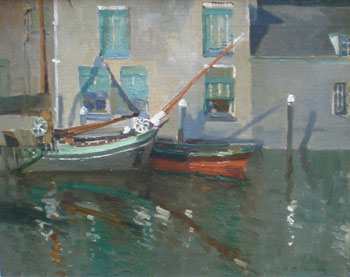 Oil on Canvas, 58x48cm. McCrossan 1863-1934 One of the most respected of the early St. Ives painters this exceptional example dates from circa 1910. Mary McCrossan was born in Liverpool and studied at the Liverpool School of Art before progressing on to the Academie Delecluse in Paris. On leaving Paris she then studied under Julius Olsson in St. Ives. She held several one-man shows at the Ballie and Beaux Arts galleries between 1909 and 1928. Lived in 126 Cheyne Walk and travelled extensively until 1929 when she moved to St. Ives permanently. Exhibited at the Royal Academy and the R.B.A.
Oil on Canvas, 58x48cm. McCrossan 1863-1934 One of the most respected of the early St. Ives painters this exceptional example dates from circa 1910. Mary McCrossan was born in Liverpool and studied at the Liverpool School of Art before progressing on to the Academie Delecluse in Paris. On leaving Paris she then studied under Julius Olsson in St. Ives. She held several one-man shows at the Ballie and Beaux Arts galleries between 1909 and 1928. Lived in 126 Cheyne Walk and travelled extensively until 1929 when she moved to St. Ives permanently. Exhibited at the Royal Academy and the R.B.A. -
Sold
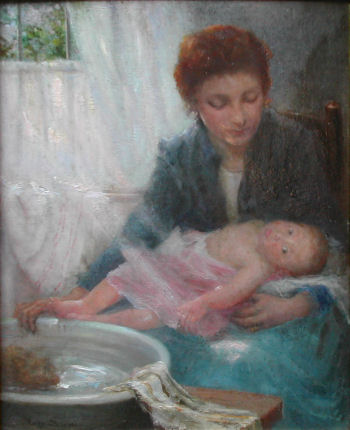 Oil on Canvas, 58x65cm. exh. 1889 - 1907 A wonderful and evocative painting by Mary Swan. A talented artist she was equally at home with various subject matter but excelled at these intimate scenes. She exhibited at numerous principal galleries both in London and in the provinces including the Royal Academy. She lived for much of her life in Bromley, Kent.
Oil on Canvas, 58x65cm. exh. 1889 - 1907 A wonderful and evocative painting by Mary Swan. A talented artist she was equally at home with various subject matter but excelled at these intimate scenes. She exhibited at numerous principal galleries both in London and in the provinces including the Royal Academy. She lived for much of her life in Bromley, Kent. -
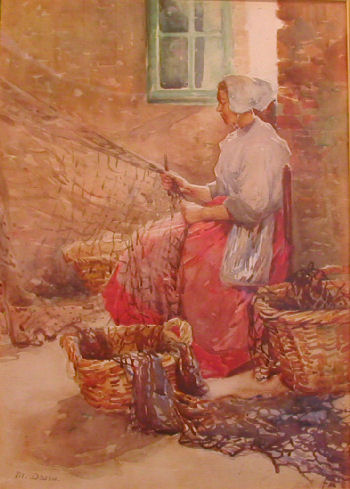 Miriam Deane exh. 1890's - 1927 A stunning watercolour by Miriam Deane who was born in Liverpool and later moved to London. An accomplished artist with a confident loose style she exhibited with considerable success at numerous venues both in London and the provinces including the London Salon, Waller Art Gallery, Liverpool and the Glasgow Institute.
Miriam Deane exh. 1890's - 1927 A stunning watercolour by Miriam Deane who was born in Liverpool and later moved to London. An accomplished artist with a confident loose style she exhibited with considerable success at numerous venues both in London and the provinces including the London Salon, Waller Art Gallery, Liverpool and the Glasgow Institute. -
Sold
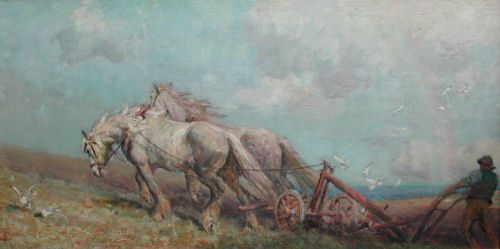 Oil on Canvas, 118x64cm. Nathaniel Hughes John Baird R.O.I. 1865 - 1935 Nathaniel Baird was born in Yetholm in Roxburghshire and was the son of John Baird the minister who is famed for his work in reforming the gypsy population and particularly for the founding of the first 'Ragged Schools'. Baird first studied under his father and then at the Coldstream Academy, Edinburgh, then London and later Paris. He had his first Royal Academy work accepted in 1883 and exhibited at many of the principal galleries from that date including the R.O.I. of which he was elected a member. He was equally at home with both oil and watercolour and a favourite subject was the heavy horse at work. He continued to exhibit until the 1930's. He moved to Devon in 1880 living at Dawlish where he was given an interesting commission by the Miller family of Torquay to paint portraits of the family. One of the sitters was the youngest daughter Agatha who was to gain worldwide fame as the crime writer Agatha Christie. Following the death of his wife in 1919 he moved from Devon to Sussex where he died in 1935.
Oil on Canvas, 118x64cm. Nathaniel Hughes John Baird R.O.I. 1865 - 1935 Nathaniel Baird was born in Yetholm in Roxburghshire and was the son of John Baird the minister who is famed for his work in reforming the gypsy population and particularly for the founding of the first 'Ragged Schools'. Baird first studied under his father and then at the Coldstream Academy, Edinburgh, then London and later Paris. He had his first Royal Academy work accepted in 1883 and exhibited at many of the principal galleries from that date including the R.O.I. of which he was elected a member. He was equally at home with both oil and watercolour and a favourite subject was the heavy horse at work. He continued to exhibit until the 1930's. He moved to Devon in 1880 living at Dawlish where he was given an interesting commission by the Miller family of Torquay to paint portraits of the family. One of the sitters was the youngest daughter Agatha who was to gain worldwide fame as the crime writer Agatha Christie. Following the death of his wife in 1919 he moved from Devon to Sussex where he died in 1935. -
Sold
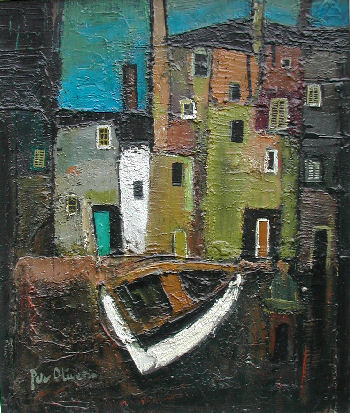 Oil on Board, 12x15cm. Oliver b.1927 Born in Jersey in the Channel Islands in 1927, he started painting during a prolonged illness and went on to study first at Exeter for his diploma in Painting and subsequently post-graduate studies in Liverpool. While still a student he exhibited work at the Redfern Gallery, London, and with the Royal Society of British Artists. Since those early days Peter Oliver has maintained strong links with the Redfern Gallery and has had a number of one-man shows with them. He has exhibited regularly in London and has also exhibited at the City Art Gallery in Salford. His work is in many collections, including the Tate Gallery, the Courtauld Institute, Manchester City Art Gallery and in the U.S.A. with the Fielding Collection New York, the Charles Berenson Collection etc.
Oil on Board, 12x15cm. Oliver b.1927 Born in Jersey in the Channel Islands in 1927, he started painting during a prolonged illness and went on to study first at Exeter for his diploma in Painting and subsequently post-graduate studies in Liverpool. While still a student he exhibited work at the Redfern Gallery, London, and with the Royal Society of British Artists. Since those early days Peter Oliver has maintained strong links with the Redfern Gallery and has had a number of one-man shows with them. He has exhibited regularly in London and has also exhibited at the City Art Gallery in Salford. His work is in many collections, including the Tate Gallery, the Courtauld Institute, Manchester City Art Gallery and in the U.S.A. with the Fielding Collection New York, the Charles Berenson Collection etc. -
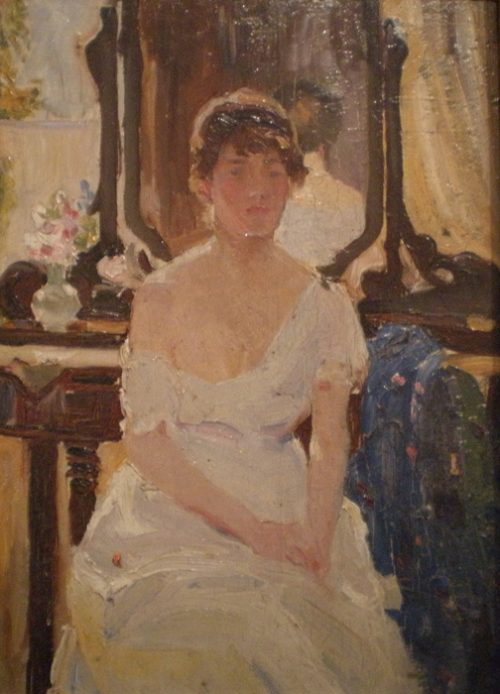 Oil on Board, 38x48cm. Connard R.A., R.W.S., N.E.A.C., N.P.S., I.S. 1875-1958 Born in Southport, Lancashire, he worked first as a house painter at the same time taking evening classes which resulted in him recieving a scholarship to the Royal College of Art to study textile design. His training as a painter began in 1898 when with the aid of a British Institution travelling scholarship he enrolled at the Atelier Julian in Paris. On his return he worked as an illustrator for Bodley Head. From 1909 he became a regular visitor with the New English Art Club and as a result developed a close relationship with Philip Wilson Street, often accompanying him on painting excursions. He quickly established himself as both a fine landscape and portrait painter and was a founder member of the National Portrait Society. He was invalided out of the army after the battle of the Somme and became an official war artist in the Royal Navy until 1918. Connard had a long and distingushed career, being elected a member of the Royal Academy in 1925.
Oil on Board, 38x48cm. Connard R.A., R.W.S., N.E.A.C., N.P.S., I.S. 1875-1958 Born in Southport, Lancashire, he worked first as a house painter at the same time taking evening classes which resulted in him recieving a scholarship to the Royal College of Art to study textile design. His training as a painter began in 1898 when with the aid of a British Institution travelling scholarship he enrolled at the Atelier Julian in Paris. On his return he worked as an illustrator for Bodley Head. From 1909 he became a regular visitor with the New English Art Club and as a result developed a close relationship with Philip Wilson Street, often accompanying him on painting excursions. He quickly established himself as both a fine landscape and portrait painter and was a founder member of the National Portrait Society. He was invalided out of the army after the battle of the Somme and became an official war artist in the Royal Navy until 1918. Connard had a long and distingushed career, being elected a member of the Royal Academy in 1925. -
Sold
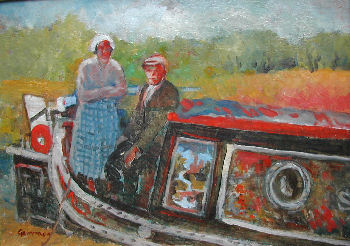 Oil on Board, 11x7cm. A painter, illustrator and writer Reg Gammon was born in Petersfield, Hampshire. In 1918 Muirhead Bone offered to get him into the Slade School but he declined as he had married. He took up instead a career as a writer and illustrator working for 'Punch' and for cycling and motoring magazines. Following the end of World War II, he moved back to the Black Mountains in Wales and became a hill farmer. It was in 1958 that Reg decided to become a full-time painter and moved to Somerset, setting up his studio in Cannington. His principal influence was Gaugin and this is evident in his lively pure palette. He achieved considerable success and was a member of both the R.W.A. and the R.O.I. In 1990 he published his biography 'One Man's Furrow, 90 years of country living'.
Oil on Board, 11x7cm. A painter, illustrator and writer Reg Gammon was born in Petersfield, Hampshire. In 1918 Muirhead Bone offered to get him into the Slade School but he declined as he had married. He took up instead a career as a writer and illustrator working for 'Punch' and for cycling and motoring magazines. Following the end of World War II, he moved back to the Black Mountains in Wales and became a hill farmer. It was in 1958 that Reg decided to become a full-time painter and moved to Somerset, setting up his studio in Cannington. His principal influence was Gaugin and this is evident in his lively pure palette. He achieved considerable success and was a member of both the R.W.A. and the R.O.I. In 1990 he published his biography 'One Man's Furrow, 90 years of country living'. -
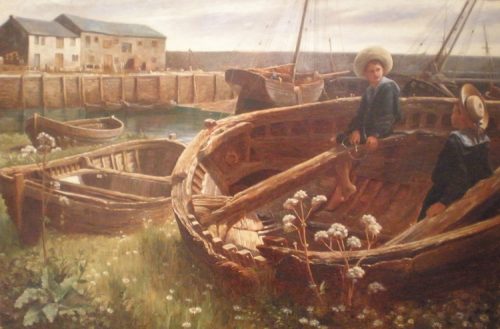 Oil on Canvas, 79x60cm. Robert Craig fl. 1879 - 1888 Little is known of this particularly gifted Scottish painter and his work is rarely on the market. He is known to have lived at Craegest, Dalkeith - an address from which exhibited five works at the Royal Scottish Academy. He also exhibited at the Glasgow Institute but appears not to have exhibited in England. Technically a fine painter with a good eye for composition, this is a delightful study from Victorian Scotland.
Oil on Canvas, 79x60cm. Robert Craig fl. 1879 - 1888 Little is known of this particularly gifted Scottish painter and his work is rarely on the market. He is known to have lived at Craegest, Dalkeith - an address from which exhibited five works at the Royal Scottish Academy. He also exhibited at the Glasgow Institute but appears not to have exhibited in England. Technically a fine painter with a good eye for composition, this is a delightful study from Victorian Scotland. -
Sold
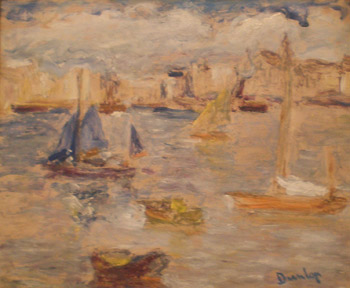 Oil on Board, 42x36cm. Ronald Ossory Dunlop R.A., R.B.A., N.E.A.C., L.G. 1896-1973 Provenance: Ex private collection. Born in Dublin, a painter of figure subjects, landscapes, portraits and still life. He was educated at Saffron Walden in Essex and worked for an advertising agency from the age of nineteen and after the First World War abandoned this for painting. He attended evening classes at the Wimbledon School of Art, and also studied in Manchester and Paris. In 1923 he founded the Emotionist Group of Writers and Artists. He held his first one-man show in 1928 at the Redfern Gallery. His work is represented in numerous public collections.
Oil on Board, 42x36cm. Ronald Ossory Dunlop R.A., R.B.A., N.E.A.C., L.G. 1896-1973 Provenance: Ex private collection. Born in Dublin, a painter of figure subjects, landscapes, portraits and still life. He was educated at Saffron Walden in Essex and worked for an advertising agency from the age of nineteen and after the First World War abandoned this for painting. He attended evening classes at the Wimbledon School of Art, and also studied in Manchester and Paris. In 1923 he founded the Emotionist Group of Writers and Artists. He held his first one-man show in 1928 at the Redfern Gallery. His work is represented in numerous public collections. -
Sold
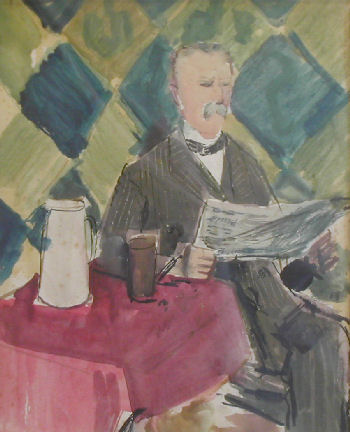 Watercolour, 70x90cm. Ruskin Spear R.A. 1911 - 1990 Born in Hammersmith, London, where he spent most of his life and which he frequently painted. An attack of polio as a child badly affected one leg so he attended Brook Green School for crippled children. At the age of fifteen he won a scholarship to the Hammersmith School of Art, another scholarship in 1930 taking him to the Royal College of Art for four year under William Rotherstein. Essentially an English painter in the Sickert tradition, his working class background was reflected in his pictures of seedy back streets and bar room life. An important painter, he painted many portraits, including Winston Churchill, Princess Anne, Margaret Thatcher, Lord Hailsham, Lord Olivier et al.
Watercolour, 70x90cm. Ruskin Spear R.A. 1911 - 1990 Born in Hammersmith, London, where he spent most of his life and which he frequently painted. An attack of polio as a child badly affected one leg so he attended Brook Green School for crippled children. At the age of fifteen he won a scholarship to the Hammersmith School of Art, another scholarship in 1930 taking him to the Royal College of Art for four year under William Rotherstein. Essentially an English painter in the Sickert tradition, his working class background was reflected in his pictures of seedy back streets and bar room life. An important painter, he painted many portraits, including Winston Churchill, Princess Anne, Margaret Thatcher, Lord Hailsham, Lord Olivier et al. -
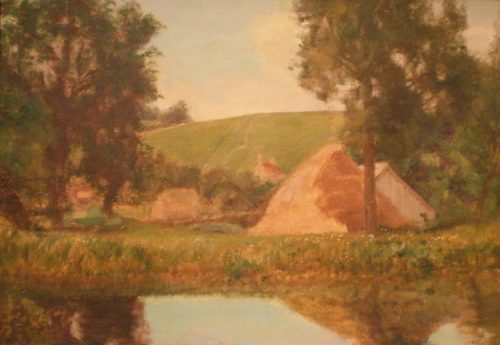 Oil on Canvas, 52x42cm. Murray R.A., P.R.I., R.S.A. 1849-1933 One of the most influential and respected painters of his period, David Murray was born in Glasgow. After spending eleven years with a mercantile firm he was to become an artist and studied at the Glasgow School of Art. In his early years he painted almost exclusively in Scotland before moving to London in 1883. Following this period he travelled extensively on the continent in particular Italy. He was knighted in 1918.
Oil on Canvas, 52x42cm. Murray R.A., P.R.I., R.S.A. 1849-1933 One of the most influential and respected painters of his period, David Murray was born in Glasgow. After spending eleven years with a mercantile firm he was to become an artist and studied at the Glasgow School of Art. In his early years he painted almost exclusively in Scotland before moving to London in 1883. Following this period he travelled extensively on the continent in particular Italy. He was knighted in 1918.

